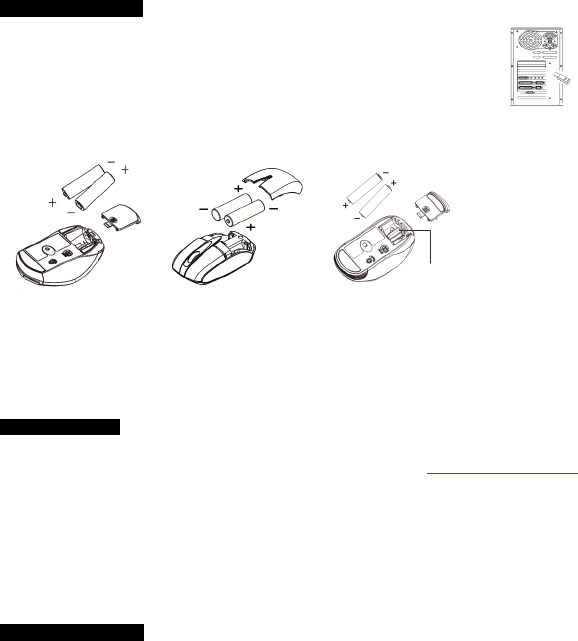Behavior Tech Computer MSM988AP3 Wireless Mouse User Manual M851 M871 Serious
Behavior Tech Computer Corporation Wireless Mouse M851 M871 Serious
User manual

Wireless Mouse
Hardware Installation M988AP III / M969AP III ; EMPREX,BTC
1. Plug the receiver connector into your available USB port on PC.
2. Make sure the batteries of the mouse are installed correctly, please follow the
polarity signs in the battery compartment.
3. Please make sure the slide switch on the back of the mouse is switched to “on”
before using the mouse. When not in use, please turn the power switch to “off” for
power saving.
M988AP III M997AP III M969AP III
¾ Change the cursor pointer speed
You can modify the mouse pointer speed settings in the control panel.
1. Open the Start Menu by clicking “Start” at the lower-left corner on the screen
2. Then click on Settings / Control Panel / Mouse
3. In the Mouse Properties window that appears, click the Motion tab
4. Move the slide bar toward either the faster end or the slower end
5. Click OK to exit and make the change effective
Pairing Procedure
The wireless mouse can operate out of the box immediately after you plug the receiver USB
connector into your PC USB port. If it can’t work, please visit our website at http://www.emprex.com/
to download and install the “Pairing Tool.”
Note:
1. You don’t have to pair ID again after changing batteries. If it can’t work, please follow the steps
above to complete ID pairing.
2. The mouse can operate freely up to 10 meter from the receiver.
3. Mouse battery life is up to 6 months. It depends on the intensity of usage.
System Requirements
- Microsoft® Windows® 7, Windows® XP and Windows Vista® operating systems
- Available USB port
English
Receiver
storage slot

FCC GUIDELINES
This equipment has been tested and found to comply with the limits for a Class B digital device, pursuant to Part 15
of the FCC Rules. These limits are designed to provide reasonable protection against harmful interference in a
residential installation. This equipment generates, uses and can radiate radio frequency energy and, if not installed
and used in accordance with the instructions may cause harmful interference to radio communications. However,
there is no guarantee that interference will not occur in a particular installation. If this equipment does cause
harmful interference to radio or television reception, which can be determined by turning the equipment off and on,
the user is encouraged to try to correct the interference by one or more of the following measures:
Reorient or relocate the receiving antenna.
Increase the separation between the equipment and receiver.
Connect the equipment into an outlet on a circuit different from that to which the receiver is connected.
Consult the dealer or an experienced radio/TV technician for help.
Use only shielded cables to connect I/O devices to this equipment.
FCC Warning: This device complies with Part 15 of the FCC Rules. Operation is subject to the following two
conditions: (1) this device may not cause harmful interference, (2) this device must accept any interference
received, including interference that may cause undesired operation.
FCC Caution: Any changes or modifications not expressly approved by the party responsible for compliance could
void the user's authority to operate this equipment.
Information to user:
The users manual or instruction manual for an intentional or unintentional radiator shall caution the user that changes
or modifications not expressly approved by the party responsible for compliance could void the user’s authority to
operate the equipment.
IMPORTANT NOTE:
FCC Radiation Exposure Statement:
This equipment complies with FCC radiation exposure limits set forth for an uncontrolled environment. End users
must follow the specific operating instructions for satisfying RF exposure compliance.
This transmitter must not be co-located or operating in conjunction with any other antenna or transmitter.